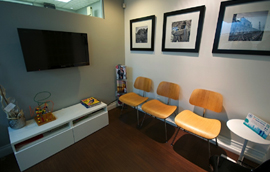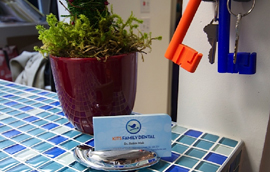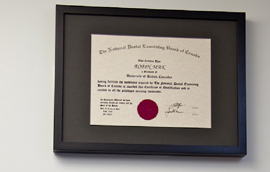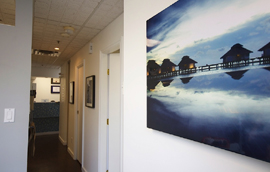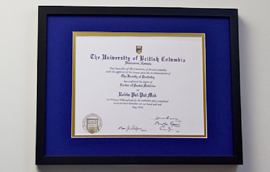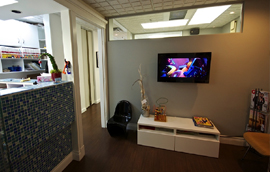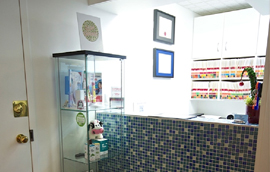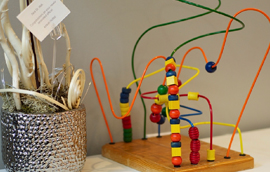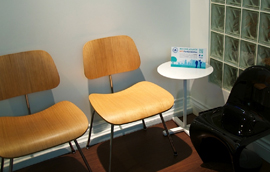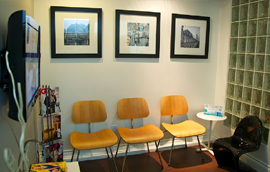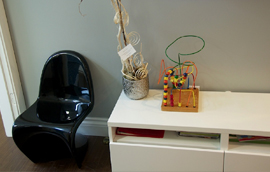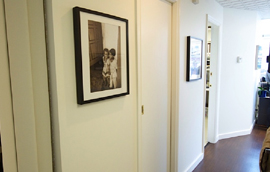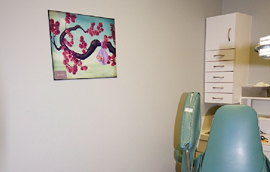At Kits Family Dental (Dentists Vancouver), we have services to take care of the entire family. You may be a kid at heart, but we also have a special section of services just for the kids themselves. Check it out!
Preventative/Periodontal
Ideally, professional dental cleanings should be performed every six months to prevent excessive plaque build-up. Patients with gum disease or deep gum pockets should have more frequent cleanings – once every 3-4 months. Lack of or very infrequent cleanings allows the build-up of plaque and tartar, which can lead to gum disease and tooth decay.
A routine dental cleaning should include scaling, root planing, and polishing.
The removal of plaque and tartar from all tooth surfaces. Scaling is usually done by hand with instruments and with electronic scalers. Ultrasonic scalers quickly remove plaque and tartar on the superficial surface of teeth, while hand scaling removes the remaining tartar attached to the root surfaces. Hand scaling also leaves the tooth surface clean and smooth to minimize tartar build-up.
Moderate to advanced gum disease causes deep, inflamed pockets to form around teeth, which traps food, plaque and tartar. Hand instruments are used to clean these deep gum pockets. Sometimes, the use of an anesthetic may be needed so that the patient is more comfortable during the procedure, which, depending on the amount of build-up, may take several appointments.
A soft rubber cup with a polishing paste is used to remove residual staining on teeth.
Sealants are a thin plastic coating that fills in the grooves of your back teeth. This smooth coating will protect against plaque and prevent bacteria from accumulating in the grooves, which may lead to a cavity.
Comfort Aids
At Kits Family Dental, we want to make your visit as comfortable as possible, so we take a little extra time and use a few tricks to make your visit a breeze. In addition to the options described below, we also have blankets, pillows, and stuffed animals upon request to keep you cozy.
We use a special gel to numb the surface of your gums and cheeks before injections. This extra step means you feel less of a pinch.
We take our time and administer the local anesthetic solution slowly so that you feel it much less.
A conscious sedation medication is prescribed to safely relieve anxiety during dental appointments. Usually 2 doses of medication are prescribed. The first dose is taken the night before your dental visit, and the second dose is taken at the dental office, 1 hour before the scheduled appointment time. Patients must, however, have someone pick them up from their dental appointment as the medication prevents them from being able to drive home.
Restorative Services
If you have a cavity in your teeth, it must be removed and replaced with a filling. A filling replaces the tooth structure lost to decay and restores the natural shape of your teeth. Different permanent filling options include amalgam fillings, white/tooth-coloured or composite fillings, and metal or porcelain inlays or onlays. If very little natural tooth structure remains, then crowns would also be needed to completely restore a tooth.
These fillings are sometimes called “silver” fillings due to their colour. These fillings are created from a mix of metals, including mercury, silver, copper and tin. Amalgam fillings are the least expensive filling used, but due to their strength and longevity, they are ideal for fixing molars with large decay.
Tooth-coloured fillings, or composite fillings, can be used to restore your teeth. This material bonds to your teeth and matches the shade of your teeth. We can use this material to close gaps between teeth, as well as repair chips, discolorations, and fill cavities. The strength and longevity of a composite filling depends on how large the filling is and its location in the mouth.
Inlays and onlays restore your teeth with custom, lab-made gold, porcelain or resin material. Inlays and onlays protect and restore large portions of the decayed tooth but do not cover the entire tooth like a crown. Inlays fill the tooth in between cusps, while onlays cover the entire chewing surface of your tooth. We often recommend inlays and onlays because they are one of the highest quality options available. They preserve tooth structure, and are more durable than amalgam or composite fillings.
A crown is a restoration that is cemented over an entire tooth, fitting like a “cap.” They are necessary when a tooth is badly broken down, and after the tooth has had root canal therapy. Crowns completely protect the tooth to prevent further fracturing and breakdown of remaining tooth structure.
If you are missing any teeth, a bridge may be a good option for you. A bridge is a fixed device that replaces one or more natural teeth. The procedure includes building crowns on the teeth to either side of the gap and attaching one or more replacements to the crowns. If missing teeth are left unfilled, your teeth may shift and move out of position. These spaces can lead to decay and may change your bite and ability to chew.
A veneer is a thin layer of restorative material placed over a tooth surface to restore uneven, discolored or even damaged teeth. There are two main types of material used to fabricate a veneer: composite (a white filling material) and porcelain. A composite veneer may be directly placed onto the tooth in 1 appointment. Porcelain veneers must be fabricated by a dental technician in a laboratory, and later bonded to the tooth. Porcelain veneers can close gaps in teeth, repair broken or chipped teeth, whiten dark, yellow, permanently stained or discoloured teeth, straighten uneven teeth, and improve the overall smile.
There are two types of dentures: partial and full dentures. A partial denture is made up of one or more false teeth, and is held in place by clasps that are supported by your other teeth. A full denture is used when all your natural teeth are missing. Both are removed at night and for cleaning. It is important to care for a denture as carefully as you would look after your natural teeth.
Surgical Services
The innermost part of the tooth has canals that run down to the root-tip. The nerves and blood vessels contained within the canals are called the pulp. Extensive decay or trauma to a tooth can affect the pulp, which can lead to an infection causing pain and/or an infection at the root-tip. With a root canal procedure, the pulp is removed, and the tooth is cleaned and sealed with a plastic filling material. A root canal treatment allows you to keep the tooth rather than having it pulled out. Keeping your tooth helps prevent your other teeth from shifting out of position, and avoids having to replace it with an artificial tooth.
Your third molars, or wisdom teeth, usually erupt during your late teens or early twenties. If they do not have enough room to grow in, or become trapped in your jaw due to being tilted or rotated, they are impacted. Impacted wisdom teeth may need to be extracted because they can cause jaw pain, infections and decay and damage to neighbouring teeth. Early removal of wisdom teeth, before they fully develop roots, can prevent the above complications.
Book your complimentary wisdom tooth consultation A dental implant is a device that resembles a tooth or group of teeth that is used to replace missing teeth.Implants appear similar to an actual tooth root and are placed within the bone with a titanium post. Dental implants will fuse with bone, however, they lack the periodontal ligament, so they will feel slightly different than natural teeth during chewing.
Invisalign, Emergency Services, Other Services
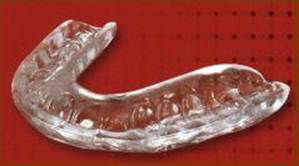
Teeth grinding, or bruxism, is involuntary grinding or clenching of your teeth, which usually occurs while you sleep. Typically, teeth grinding is stress-related, but can also be caused by misalignment of your teeth. This grinding can create large amounts of destructive forces on your teeth, jaw joints and jaw muscles. Symptoms of grinding include sore jaw muscles, headaches and neck pain, especially when experienced in the morning when you wake up. Evidence of grinding may be visible as damage to the edges of your teeth and/or gum recession. A nightguard may be the answer to relieve this pain and prevent further damage caused to your teeth. A nightguard is custom-made to fit over your upper or lower teeth and allows your teeth to glide over the guard instead of your opposing teeth.
A clear alternative to braces!
Invisalign is a series of custom-made clear plastic “Aligners” are made to move your teeth. Each Aligner moves your teeth incrementally, so you wear each Aligner for about 2 weeks, moving from 1 Aligner to the next until the final position of your teeth is achieved. The Aligners look similar to clear tooth-whitening trays, but are much stronger, and almost invisible.

See more on our Invisalign Kitsilano page >>
Teeth Whitening – Custom-made whitening trays for your upper and lower teeth are made from impressions. Whitening gel is placed in the trays and worn in the mouth for about 30 minutes to whiten your teeth. Read more on our
Teeth Whitening FAQ’s page.
The Odyssey Navigator is the name of the soft tissue diode laser we have at Kits Family Dental.
Using laser-assisted dentistry, we can provide services that were previously referred outside of our office. We can now perform minor surgical procedures, such as frenectomies with minimal anesthesia. Frenectomies involve the removal of a frenum, the attachment between two tissues, such as the one that connects your lip to your upper jaw or the band of tissue underneath your tongue. This is done in some cases to allow for more freedom of movement.
The Odyssey Navigator can also help us help take away the pain of a canker sore or cold sore and speed the healing time. If treatment is started early enough (during the tingling stage) it may even prevent the eruption of the cold sore.
We can use it to help speed the healing time of other mouth wounds or trauma because the heat of the lazer brings blood and immune cells to the site.
It is also helpful in providing preventative care such as sterilizing deep pockets around teeth to kill bacteria that causes chronic bleeding gums and gum inflammation.
Laser dentistry lowers the chances of infection and post-operative complications because it results in quicker healing, meaning less opportunities for bacteria to cause problems. In addition, sutures are rarely needed for procedures performed with a laser.
Lasers can be used with restorative dentistry when preparing teeth for a crown. It is used to ensure impressions are clear, allowing a better fit of the crown, and also to prevent the gums from bleeding, again which makes fitting and cementing the crown easier and quicker
The Odyssey Navigator allows us to do some things that could already be done in our office, but we can do them faster, and with less pain.
Over 500 cases of oral cancer were documented by the BC Cancer society in 2009. Over 80% of those cases could have been detected by a dentist doing oral cancer screening. It is crucial that oral cancer be detected early to improve the chances of a positive outcome. Dentists will notice suspicious lesions in the mouth before the patient has any of the other symptoms of oral cancer.
Now, with the help of a VELscope machine, it’s even easier for dentists to detect oral cancer or other oral diseases during your regular dental exams!
The VELscope can help clinicians detect cancerous and pre-cancerous lesions and other lesions that might not be apparent to the naked eye.
- It is a hand held device that helps dentists and hygienists detect a wide variety of oral diseases
- It can be used in conjunction with conventional oral exams
- It’s non-invasive
How does it work?
- It emits a safe blue light into the oral cavity
- This light causes fluorophores to fluoresce; however, this cannot be seen by the human eye
- The VELscope’s filter makes it possible to see the fluorescence of the fluorophores by blocking out the blue light emitted and allowing the operator to focus on the problematic areas. This is possible because the fluorophores emit their own light, in shades of green yellow and red.
- Fluorescence? What? Fluorescence occurs when light is taken in by human tissue and creates a molecular excitation that emits the light again at a different wavelength
- The VELscope is not a standalone test. It provides visual information that is impossible to attain otherwise. It is meant for use alongside with conventional oral soft tissue examinations.
What does this mean for me?
- The VELscope is an examination that takes approximately 3 minutes, while providing no discomfort to you.
- All that’s being done is emitting light into your mouth, which is generated by light emitting diodes.
- It is completely safe!
- It is used by over 6000 dentists, with over 6 million exams performed.
Periowave is a pain-free, safe, effective, and quick treatment that does not involve heat or surgery. It uses a photodisinfection reaction to destroy bacteria and toxins that are left after scaling and root planing, resulting in much less bacteria left in the patients mouth below the gum line. The area below the gum line is is traditionally difficult to access by the patient during home care follow up. These bacteria and toxins can sometimes lead to infections requiring antibiotics to treat. Because these bacteria can now be destroyed at the dental visit, infections requiring antibiotics can often be avoided.
Periowave utilizes a cold diode laser and doesn’t damage root surfaces, dental materials, or surrounding tissues. Also used for the treatment of periodontitis, gingivitis, endontics and peri-implantitis disease, Periowave has also been clinically shown to reduce pocket depth, bleeding on probing and improve attachment level.
Read more at the Periowave web site
Save
 Teeth grinding, or bruxism, is involuntary grinding or clenching of your teeth, which usually occurs while you sleep. Typically, teeth grinding is stress-related, but can also be caused by misalignment of your teeth. This grinding can create large amounts of destructive forces on your teeth, jaw joints and jaw muscles. Symptoms of grinding include sore jaw muscles, headaches and neck pain, especially when experienced in the morning when you wake up. Evidence of grinding may be visible as damage to the edges of your teeth and/or gum recession. A nightguard may be the answer to relieve this pain and prevent further damage caused to your teeth. A nightguard is custom-made to fit over your upper or lower teeth and allows your teeth to glide over the guard instead of your opposing teeth.
Teeth grinding, or bruxism, is involuntary grinding or clenching of your teeth, which usually occurs while you sleep. Typically, teeth grinding is stress-related, but can also be caused by misalignment of your teeth. This grinding can create large amounts of destructive forces on your teeth, jaw joints and jaw muscles. Symptoms of grinding include sore jaw muscles, headaches and neck pain, especially when experienced in the morning when you wake up. Evidence of grinding may be visible as damage to the edges of your teeth and/or gum recession. A nightguard may be the answer to relieve this pain and prevent further damage caused to your teeth. A nightguard is custom-made to fit over your upper or lower teeth and allows your teeth to glide over the guard instead of your opposing teeth.


